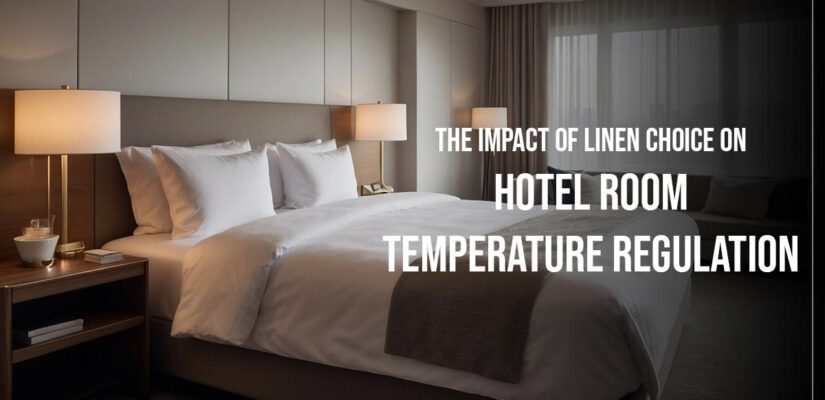
The Impact of Linen Choice on Hotel Room Temperature Regulation
When guests check into a hotel, they expect a comfortable and restful stay, which largely depends on factors like room temperature and the quality of bedding. While many hotels focus on high-tech solutions like advanced HVAC systems or smart thermostats, one often overlooked but crucial element is the choice of linen. The type of linen used in hotel rooms can significantly impact temperature regulation, guest comfort, and overall satisfaction. This blog explores how linen choices affect temperature control and offers insights into selecting the best materials for optimal comfort. Partnering with reputable hotel linen suppliers in Chennai can further enhance the quality and effectiveness of their bedding choices.
Understanding the Role of Linen in Temperature Regulation
Linen is more than just a decorative element in a hotel room; it plays a critical role in regulating temperature and ensuring guest comfort. The main types of linen that impact temperature control are bed sheets, pillowcases, duvet covers, and mattress protectors. Each type of linen interacts differently with the room’s ambient temperature and the guest’s body temperature.
1. Material Matters: Cotton vs. Polyester
Cotton is a popular choice for hotel linens due to its breathability and softness. It is highly absorbent and allows for better air circulation, which helps regulate body temperature and wick away moisture. This can be especially beneficial in warmer climates or during the summer months when guests are more likely to experience night sweats. A reputable hotel linen supplier often recommends cotton for its comfort and moisture-wicking properties.
On the other hand, polyester and polyester-blend fabrics are less breathable but offer durability and wrinkle resistance. They tend to trap heat, which may be advantageous in cooler climates but can lead to discomfort in warmer settings. Hotels located in regions with fluctuating temperatures or those catering to a diverse clientele might need to balance cotton and polyester blends to accommodate varying needs.
2. Thread Count and Weave
Thread count refers to the number of threads woven into a square inch of fabric. Higher thread counts generally indicate a denser and softer fabric. While high thread count linens are often associated with luxury and comfort, they can also affect temperature regulation. For instance, very high thread counts may lead to less breathability, which can trap heat and make guests feel overheated.
The weave of the fabric also plays a role in temperature regulation. Percale weaves, characterized by their crisp and cool texture, are ideal for warmer climates as they promote airflow and reduce heat retention. Sateen weaves, known for their silky finish, are more heat-retentive and better suited for cooler environments.
3. The Impact of Duvet Covers and Mattress Protectors
Duvet covers and mattress protectors contribute significantly to the overall temperature management in a hotel room. Duvet covers made from lightweight cotton or moisture-wicking materials can help maintain a comfortable sleeping temperature by allowing excess heat to escape. Conversely, heavier duvet covers might be preferable in cooler climates to provide additional warmth.
Mattress protectors, often overlooked, can also influence temperature control. Protectors made from breathable materials like cotton or those with cooling technology can enhance comfort by reducing heat buildup. It is essential for hotels to select protectors that balance protection with temperature regulation.
4. Seasonal Adjustments
To optimize guest comfort throughout the year, hotels should consider seasonal adjustments to their linen offerings. In warmer months, lightweight and breathable linens can prevent overheating, while in colder months, adding flannel sheets or thermal duvet covers can enhance warmth. Seasonal changes in linen can also help in managing laundry costs and extending the lifespan of the linens.
Hotels might also offer options for guests to choose their preferred linen types based on their comfort needs. This could include providing additional blankets or offering a choice between different types of bedding materials.
5. Maintenance and Care
Proper maintenance and care of linens are crucial for ensuring their effectiveness in temperature regulation. Regular laundering and proper drying techniques can preserve the breathability and softness of the fabrics. Hotels should adhere to recommended care instructions for each type of linen to maintain their performance and extend their longevity.
Additionally, addressing issues such as pilling or fraying can prevent discomfort and ensure that the linens continue to perform well in regulating temperature. Regular inspections and timely replacements are essential to maintaining high standards of guest comfort.
6. Guest Feedback and Customization
Finally, hotels should actively seek guest feedback regarding their linen choices and overall comfort. Personalized surveys or comment cards can provide valuable insights into guest preferences and experiences. Based on this feedback, hotels can adjust their linen choices and make informed decisions about future purchases, potentially sourcing from hotel linen manufacturers in India to meet their specific needs.
Customizing linen options to cater to the specific needs of different guest demographics can enhance satisfaction and loyalty. For instance, offering hypoallergenic bedding for guests with sensitivities or providing extra pillows and blankets for families can further improve the guest experience.
The choice of linen in a hotel room has a significant impact on temperature regulation and overall guest comfort. By carefully selecting materials, thread counts, and weaves, hotels can create an environment that supports restful sleep and enhances guest satisfaction. Seasonal adjustments, proper maintenance, and guest feedback further contribute to optimizing linen performance and ensuring a positive guest experience. As hotels continue to prioritize comfort and convenience, paying attention to the impact of linen on temperature regulation will remain a crucial element in providing a superior stay.